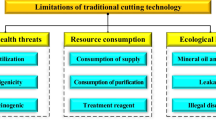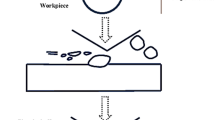Abstract
Nano-cutting fluids technology proved its effectiveness to enhance the quality of the machining processes’ performance, especially for difficult-to-cut materials, as these materials have potential applications in different industries, including automotive, gas turbine, and aerospace. Thus, the development, understanding, and investigation of the nano-cutting-fluid mechanisms are highly essential. The main objective of this work is to study and analyze the nano-cutting fluid heat transfer mechanisms. A proposed heat transfer model has been developed in this work to provide a solid physical understanding of heat dissipation when machining with nanofluids. In addition, a comparative performance analysis between multi-walled carbon nanotubes (MWCNTs) and alumina (Al2O3) nano-cutting fluids has been presented, discussed, and validated throughout the current study. The proposed model findings offer physical explanations that justify the tool performance results presented in a previous work since MWCNTs nanofluid offered better heat transfer performance (in terms of heat convection coefficient and thermal diffusivity) compared to Al2O3 nano-cutting fluid when cutting nickel-based alloys.



Similar content being viewed by others
Abbreviations
- Bi:
-
Biot number
- C p :
-
The protective film-specific heat
- d :
-
The separation distance between the workpiece and cutting tool surfaces
- \({E}_{\mathrm{in}}\) :
-
Input/generated thermal energy rate
- \({E}_{\mathrm{out}}\) :
-
Output/dissipated thermal energy rate
- f c :
-
The cutting force
- h :
-
The nano-cutting fluid mixture convection coefficient
- K :
-
The resultant nanofluid thermal conductivity
- m film :
-
The protective film mass
- MQL:
-
Minimum quantity lubrication
- MWCNTs:
-
Multi-walled carbon nanotubes
- \({q}^{\mathrm{^{\prime}}\mathrm{^{\prime}}\mathrm{^{\prime}}}\) :
-
Amount of heat generation
- s :
-
The protective film thickness
- T ∞ :
-
The ambient temperature
- T film :
-
The protective film temperature
- T interface :
-
The cutting interface temperature
- t o :
-
The undeformed chip thickness
- T S1 :
-
The workpiece surface temperature
- v :
-
The cutting velocity
- V film :
-
The protective film volume
- w :
-
The chip width
- \({\Delta E}_{\mathrm{stored}}\) :
-
The change of thermal energy content
- \({\rho }_{\mathrm{film}}\) :
-
The protective film density
- \(\alpha\) :
-
The protective film thermal diffusivity
References
Kadam GS, Pawade RS (2017) Surface integrity and sustainability assessment in high-speed machining of Inconel 718–an eco-friendly green approach. J Clean Prod 147:273–283
Bleicher F, Finkeldei D, Siller A (2016) Machining of difficult-to-cut materials. Annals of DAAAM & Proceedings 27
Miller S (1995) Advanced materials mean advanced engines. Interdisc Sci Rev 20(4):117–129
Davim JP (2011) Machining of hard materials.: Springer Science & Business Media
Wang Z et al (2003) Hybrid machining of Inconel 718. Int J Mach Tools Manuf 43(13):1391–1396
Alauddin M et al (1998) Cutting forces in the end milling of Inconel 718. J Mater Process Technol 77(1):153–159
Dudzinski D et al (2004) A review of developments towards dry and high-speed machining of Inconel 718 alloy. Int J Mach Tools Manuf 44(4):439–456
Lu T (2014) A metrics-based sustainability assessment of cryogenic machining using modeling and optimization of process performance (Order No. 3648951). Available from ProQuest One Academic. (1650213824). Retrieved from https://uaeu.idm.oclc.org/dissertations-theses/metrics-based-sustainability-assessment-cryogenic/docview/1650213824/se-2
Sharma VS, Dogra M, Suri N (2009) Cooling techniques for improved productivity in turning. Int J Mach Tools Manuf 49(6):435–453
Krishna PV, Srikant RR, Padmini R, Viswaditya JLPP (2013) Application of nanomaterials as coolants/lubricants in machining. In International Conference on Advanced Nanomaterials & Emerging Engineering Technologies (pp. 674–682). IEEE
Krajnik P, Pusavec F, Rashid A (2011) Nanofluids: properties, applications and sustainability aspects in materials processing technologies. Advances in Sustainable Manufacturing. Springer, pp 107–113
Saberi A et al (2016) Improvement of surface grinding process performance of CK45 soft steel by minimum quantity lubrication (MQL) technique using compressed cold air jet from vortex tube. J Clean Prod 131:728–738
Goindi GS, Sarkar P, Jayal AD, Chavan SN, Mandal D (2018) Investigation of ionic liquids as additives to canola oil in minimum quantity lubrication milling of plain medium carbon steel. Int J Adv Manuf Technol 94(1):881–896
Amrita M, Srikant R, Sitaramaraju A (2014) Performance evaluation of nanographite-based cutting fluid in machining process. Mater Manuf Processes 29(5):600–605
Khandekar S et al (2012) Nano-cutting fluid for enhancement of metal cutting performance. Mater Manuf Processes 27(9):963–967
Kandile NG, Harding DR, Biresaw G, Mittal KL (2017) Nanotechnology and performance development of cutting fluids: the enhanced heat transfer capabilities of nanofluids. In Surfactants in Tribology (pp. 103–148). CRC Press
Sharma AK, Tiwari AK, Dixit AR (2016) Effects of minimum quantity lubrication (MQL) in machining processes using conventional and nanofluid based cutting fluids: a comprehensive review. J Clean Prod 127:1–18
Sharma AK, Tiwari AK, Dixit AR (2015) Progress of nanofluid application in machining: a review. Mater Manuf Processes 30(7):813–828
Rajmohan T, Sathishkumar S, Palanikumar K (2017) Effect of a nanoparticle-filled lubricant in turning of AISI 316L stainless steel (SS). Part Sci Technol 35(2):201–208
Singh RK, Sharma AK, Dixit AR, Tiwari AK, Pramanik A, Mandal A (2017) Performance evaluation of alumina-graphene hybrid nano-cutting fluid in hard turning. J Clean Prod 162:830–845
Bakalova T et al (2017) The application potential of SiO2, TiO2 or Ag nanoparticles as fillers in machining process fluids. J Clean Prod 142:2237–2243
Hegab H, Umer U, Esawi A, Kishawy HA (2020) Tribological mechanisms of nano-cutting fluid minimum quantity lubrication: a comparative performance analysis model. Int J Adv Manuf Technol 108(9):3133–3139
Hegab H, Kishawy HA, Umer U, Mohany A (2019) A model for machining with nano-additives based minimum quantity lubrication. Int J Adv Manuf Technol 102(5):2013–2028
Mia M, Morshed MS, Kharshiduzzaman M, Razi MH, Mostafa MR, Rahman SM, Kamal AM (2018) Prediction and optimization of surface roughness in minimum quantity coolant lubrication applied turning of high hardness steel. Measurement 118:43–51
Rahim EA, Ibrahim MR, Rahim AA, Aziz S, Mohid Z (2015) Experimental investigation of minimum quantity lubrication (MQL) as a sustainable cooling technique. Procedia CIRP 26:351–354
Qu S, Yao P, Gong Y, Chu D, Yang Y, Li C, Hou Y (2022) Environmentally friendly grinding of C/SiCs using carbon nanofluid minimum quantity lubrication technology. J Clean Prod 366:132898
Barewar SD, Kotwani A, Chougule SS, Unune DR (2021) Investigating a novel Ag/ZnO based hybrid nanofluid for sustainable machining of inconel 718 under nanofluid based minimum quantity lubrication. J Manuf Process 66(313–32):4
Jamil M, Khan AM, Hegab H, Gong L, Mia M, Gupta MK, He N (2019) Effects of hybrid Al2O3-CNT nanofluids and cryogenic cooling on machining of Ti–6Al–4V. Int J Adv Manuf Technol 102(9):3895–3909
Hegab H, Umer U, Soliman M, Kishawy HA (2018) Effects of nano-cutting fluids on tool performance and chip morphology during machining Inconel 718. Int J Adv Manuf Technol 96(9):3449–3458
Khanafer K, Eltaggaz A, Deiab I, Agarwal H, Abdul-Latif A (2020) Toward sustainable micro-drilling of Inconel 718 superalloy using MQL-Nanofluid. Int J Adv Manuf Technol 107(7):3459–3469
Hegab H, Umer U, Deiab I, Kishawy H (2018) Performance evaluation of Ti–6Al–4V machining using nano-cutting fluids under minimum quantity lubrication. Int J Adv Manuf Technol 95(9):4229–4241
Loos M (2014) Carbon nanotube reinforced composites: CNT Polymer Science and Technology: Elsevier
Funding
This study was funded by the Natural Sciences and Engineering Research Council of Canada (NSERC).
Author information
Authors and Affiliations
Corresponding author
Ethics declarations
Ethical approval
The authors confirm that this work does not contain any studies with human participants performed by any of the authors.
Consent to participate
Not applicable.
Consent for publication
The author grants the publisher the sole and exclusive license of the full copyright in the contribution, which license the publisher hereby accepts.
Competing interests
The authors declare no competing interests.
Additional information
Publisher's note
Springer Nature remains neutral with regard to jurisdictional claims in published maps and institutional affiliations.
Rights and permissions
Springer Nature or its licensor (e.g. a society or other partner) holds exclusive rights to this article under a publishing agreement with the author(s) or other rightsholder(s); author self-archiving of the accepted manuscript version of this article is solely governed by the terms of such publishing agreement and applicable law.
About this article
Cite this article
Hegab, H., Kishawy, H.A. Heat transfer mechanisms of nano-cutting fluids: a comparative performance analysis model. Int J Adv Manuf Technol 124, 1429–1435 (2023). https://doi.org/10.1007/s00170-022-10579-4
Received:
Accepted:
Published:
Issue Date:
DOI: https://doi.org/10.1007/s00170-022-10579-4




